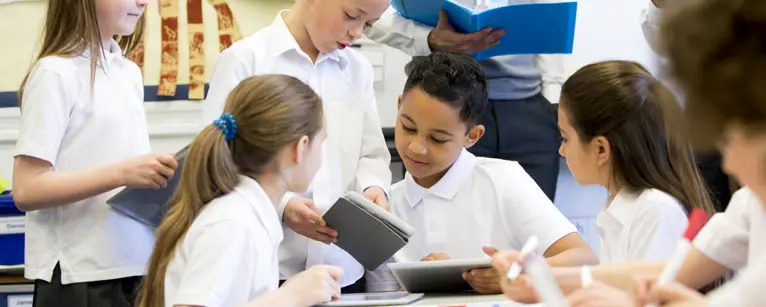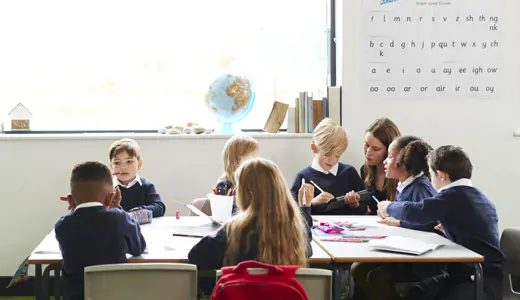Maths matters. Everyone uses it every day, often without thinking about it. But many people struggle with maths – both in terms of skills and, importantly, in confidence working with numbers.
Many children and adults see maths as something scary, difficult, or irrelevant to their lives. Research carried out by Cambridge and the Nuffield Foundation shows that children as young as 6 experience maths anxiety, even though the majority of those with maths anxiety have normal performance for their age[1].
But these negative attitudes can be changed with the right support. Helping primary and secondary age students to develop positive attitudes is vital in supporting them to engage with maths learning and invest in their future.
Maths isn’t just something that is left behind at school. Children who have strong numeracy skills are more likely to stay in education longer, to be in work as adults, and to earn more throughout their lives[2]. And life beyond school is full of everyday maths: whether it’s managing finances, scheduling, measuring or understanding statistics – we all use numbers every day.
For learners of any age, understanding why you’re learning something can help you see the point of engaging with it. Focusing on where maths is used in everyday life helps pupils understand why it’s important. They need to see how the maths they learn in school relates to life beyond the classroom.
National Numeracy has worked with LifeSkills to develop classroom activities for exploring where maths is used in day-to-day life. For primary age children, this focuses on hobbies and sport, while for secondary students the activity explores the maths used in jobs as well as daily life.
For either age group, though, there are our tips teachers can use to support students to build a positive relationship with maths.
- Put maths in real-life contexts
This is a simple way to make maths feel more relevant and to develop students’ confidence with using and applying what they’ve learnt. For any maths being learnt, talk with students about where it can be used in life outside school. Make sure they know that maths isn’t just about doing sums on a piece of paper – it has real-life applications.
Look out for resources that relate to situations your class might come across in real life: going to the shops, baking, catching a bus, playing football. If you can actually do any of these activities with them to put maths into practice, so much the better.
All of this will help students to see the point of what they’re learning and carry it forward with them into other aspects of their life.
- Bring maths into other areas of the curriculum
Highlighting the numeracy in other areas of the curriculum can also help learners build confidence with maths. It helps them recognise where maths is useful and also develops their ability to use maths in a range of contexts.
As a teacher, taking a topic or subject and determining ‘where’s the maths in that?’ is a great place to start. Timelines might fit into history topics, for example, or graphs into geography. Or you could take an aspect of maths that you’re teaching and explore ways it can be supported by other curriculum areas – for instance, where might fractions come into other subjects? Rhythm in music could be one example. Work with colleagues with various specialisms to explore this if you can. You could have a school maths day or maths week where mathematical opportunities are brought into all lessons – National Numeracy Day could be a good time to try this.
- Create a number rich environment
Having a school environment full of numbers encourages learners to engage with maths throughout their daily lives and routines. This might include the classroom, the playground, shared areas around the school such as the corridors, hall and canteen – and could even extend to the local area and home.
This can look different in different settings but some ideas include: adding maths questions to displays in shared areas; having an interactive display focused on real-life maths; inviting speakers in to talk about where they use maths in their jobs; building numeracy into events such as sports day; creating maths trails around the school; setting up ‘estimation stations’ for children to interact with; making sure role play areas in KS1 include maths opportunities (e.g. a shop); and generally using maths as part of the school routine – for instance, using time throughout the day.
Having numbers and maths all around them helps learners see it as a normal part of everyday life. It’s not something to be scared of and it’s not something that only happens in the classroom.
- Focus on a growth mindset
When it comes to maths, many people have a fixed mindset and believe that it’s something they either can or can’t do. This belief can start at a young age and increase as children grow older, limiting their aspirations if it’s left unchallenged. So it’s important to help learners believe that their ability is not set in stone and that everyone can improve their skills and confidence. This is what is known as a growth mindset.
You can support your learners to develop a growth mindset by normalising struggle – everyone finds things difficult sometimes but that doesn’t mean they can’t get there in the end. Praising the effort learners have put in rather than praising them for being clever or talented also makes a difference, as it encourages pupils to believe that hard work is more important than in-built ability. Celebrating mistakes is another way to promote a growth mindset – if we make mistakes, we learn from them, and that’s a good thing.
We can also encourage learners to practise, try another way, and not give up. And asking pupils about what they have learnt in their work is a simple way to shift the focus from being purely on the end result to ‘how did we get there.’
Building positive attitudes towards maths helps keep students engaged and learning – and showing them the value of maths is a key part of this. The primary and secondary activities we have created with Barclays LifeSkills explore where maths is used outside of the classroom and can be used to start some of these conversations.
[1] https://www.repository.cam.ac.uk/bitstream/handle/1810/290514/Szucs%2041179%20-%20Main%20Public%20Output%208%20March%202019.pdf?sequence=1&isAllowed=y
[2] https://discovery.ucl.ac.uk/id/eprint/1566245/1/parsons2006does.pdf










